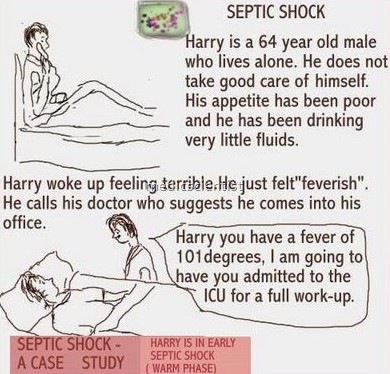Article Contents ::
- 1 Sepsis (Septic Shock) CLINICAL MANIFESTATIONS
- 2 MAJOR COMPLICATIONS of Sepsis (Septic Shock)
- 3 Cardiopulmonary –
- 4 Septic hypotension –
- 5 Renal complications of Sepsis (Septic Shock)
- 6 Coagulation abnormalities –
- 7 Neurological complications –
- 8 LABORATORY FINDINGS in Sepsis (Septic Shock)
- 9 ARTERIAL BLOOD GAS ANALYSIS
- 10 CHEST X–RAY
- 11 ECG
- 12 DIAGNOSIS of Sepsis (Septic Shock)
Sepsis (Septic Shock) CLINICAL MANIFESTATIONS
- There is some primary infection or disease.
- Mild sepsis chan,ges to severe, and to septic shock. Patient may be hormo, hypo or hyper thermic i.e. fever normal, low or high Fever is absent in neonates, elderly, alcoholics and in uremia.
- Hyperventilation is early sign.
- Then there is disorientation, confusion, encephalopathy.
- No focal neurological signs are seen. There is hypotension.
- Disseminated intravascular coagulation leading to acrocyanosis, ischemia and necrosis of tissues of fingers and toes is seen.
- Cellulitis, pustules, bullae, hemorrhagic lesions, diffuse cutaneous lesions occur.
- In Neisseria meningitides, Hemophilus influenza, Rocky Mountain Spotted Fever (tickbite) infection Cutaneous Petechiae/Purpura seen.
- Pseudomonas aeroginosa-Ecthyma gangrenosum is seen i.e. central bullous lesion with haemorrhage and necrosis surrounded by edema.
- It is also seen in neutropenic patients. Gastrointestinal Manifestations – Nausea, vomiting, diarrhoea, ileus.
- Stress ulcers, Upper GI bleeding, cholestatic jaundice with increased serum bilirubin, increased alkaline phosphatase, hepatic dysfunction.
- It may be reversible. –
- Severe hypotension may lead to hepatic injury or ischemic bowel necrosis.
- There is lactic acidosis, hyperglycemia (in diabetics), hypoglycemia.
MAJOR COMPLICATIONS of Sepsis (Septic Shock)
Cardiopulmonary –
- Ventricular perfusion mismatch leading to fall in arterial P02
- Pulmonary oedema due to increased pulmonary water content.
- Pa02 / Fi02 < 200 mmHg indicates development of acute respiratory distress syndrome – ARDS.
- Respiratory muscle failure results in hypoxaemia and hypercapnia.
- In ARDS pulmonary wedge pressure less than 18 mmHg.
- If PWP is more than 18 mm then it suggests fluid volume overload or cardiac failure.
- Viral pneumonia or pneumonia due to Pneumocystis
- carinii is just like ARDS. •
Septic hypotension –
- is due to diffuse capillary leakage of intravascular fluid, dehydration, insensible fluid losses, vomiting, diarrhoea, polyuria.
- After fluid administration in septic shock, cardiac output increases and systemic vascular resistance decreases.
- In cardiogenic shock this does not occur. There is decreased cardiac output and increased systemic vascular resistance.
- In anaphylaxis, beri-beri, cirrhosis, nitroprusside or narcotic overdose there is like septic shock increased cardiac output and decreased systemic vascular resistance with administration of fluids.
- In severe sepsis there is depressed myocardial function, increase in end-diastolic volume, increased endsystolic volume, decreased ejection fraction within 24 , hours. Cardiac output is maintained but ejection fraction decreased due to ventricular dilatation.
- There is low systemic vascular resistance – hypotension.
- Multi-organ failure leads to decreased systemic vascular resistance.
Renal complications of Sepsis (Septic Shock)
- · Oliguria
- · Azotemia (increased blood urea)
- · Proteinuria
- · Non-specific urinary casts
- · Polyuria
- · Hyperglycemia.
- Acute tubular necrosis leads to renal failure due to hypotension and ischemia.
- Some “patients may have glomerulonephritis, renal cortical necrosis, interstitial nephritis or drug-induced as with aminoglycosides.
Coagulation abnormalities –
- Thrombocytopenia in 10 to 30% patients.
- Platelets less than 50,000jml in disseminated intravascular coagulation due to diffuse endothelial injury or microvascular thrombi.
Neurological complications –
- Critical polyneuropathy occurs when weeks to months pass with sepsis preventing weaning from ventilatory support.
- There is distal motor weakness.
LABORATORY FINDINGS in Sepsis (Septic Shock)
- · Leucocytosis
- · Thrombocytopenia
- · Hyperbilirubinemia
- · Proteinuria
- · Leucopenia
- · Toxic granulation in neutrophils
- · Increased prothrombin time
- · Decreased fibrinogen
- · Presence of D-dimers (DIe-Disseminated Intra-
- vascular Coagulation)
- · Azotemia ,
- · Increased SGPT
- · Increased SGOT
- · Hemolysis suggests Clostridial bacteremia, malaria, drug reaction, DIe.
ARTERIAL BLOOD GAS ANALYSIS
- Hyperventilation results in respiratory alkalosis, later lactic acidosis, metabolic acidosis, increased anion.gap, hypoxaemia corrected with 100% oxygen. Later, due to right to left shunting there is refractory hypoxaemia.
CHEST X–RAY
- Normal or shows pneumonia, volume overload, or ARDS.
ECG
- Sinus tachycardia, ST-T changes
DIAGNOSIS of Sepsis (Septic Shock)
- Fever or hypothermia, tachypnea, tachycardia, leukocytosis, leukopenia, altered mental state, thrombocytopenia, hypotension are all features of septic shock.
- Indications of infection seen.
- SIRS – noninfectious etiology in burns, pancreatitis, adrenal insufficiency, pulmonary embolism, dissecting or ruptured aortic aneurysm, myocardial infarction, occult haemorrhage, cardiac tamponade, post cardio-pulmonary bypass syndrome, anaphylaxis, drug overdose.
- 2 blood samples 10 ml each from 2 different sites at 2 different times are sent for culture.
- Staphylococcus aureus seen in 48 hours.
- Gram negative infection yield is low.
- Gram’s staining and culture of material from primary site of infection or skin may reveal the microbial etiology.
- Detection of endotoxin in blood is by Limulus Lysate test.
- Blood level of IL-6 and cytokine assays are of limited value.


